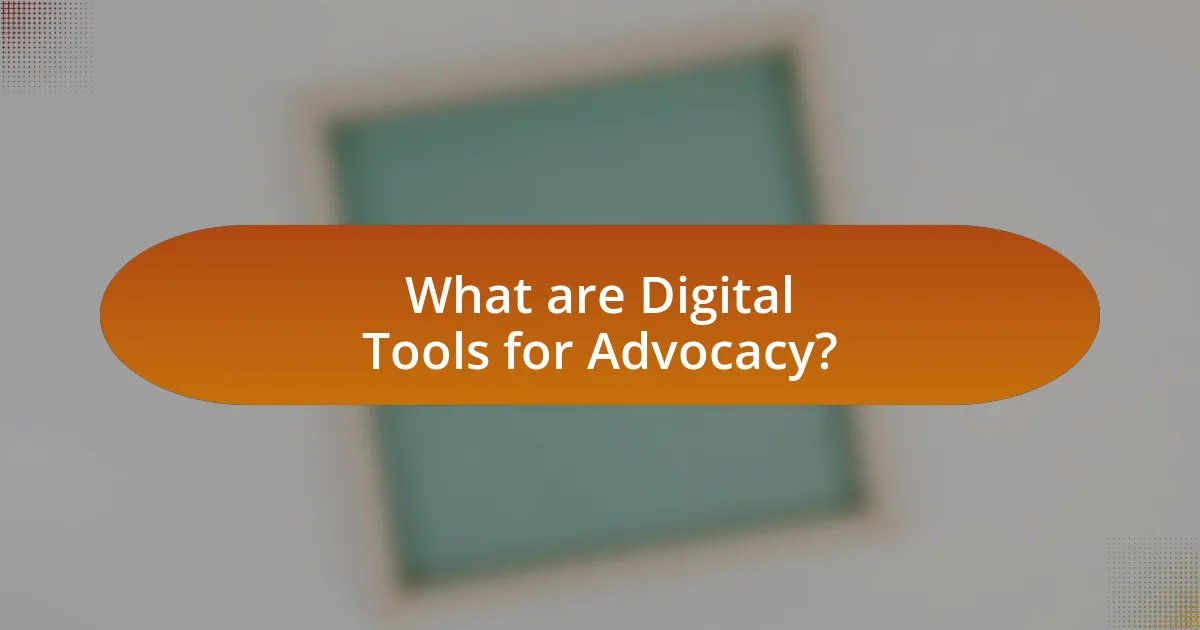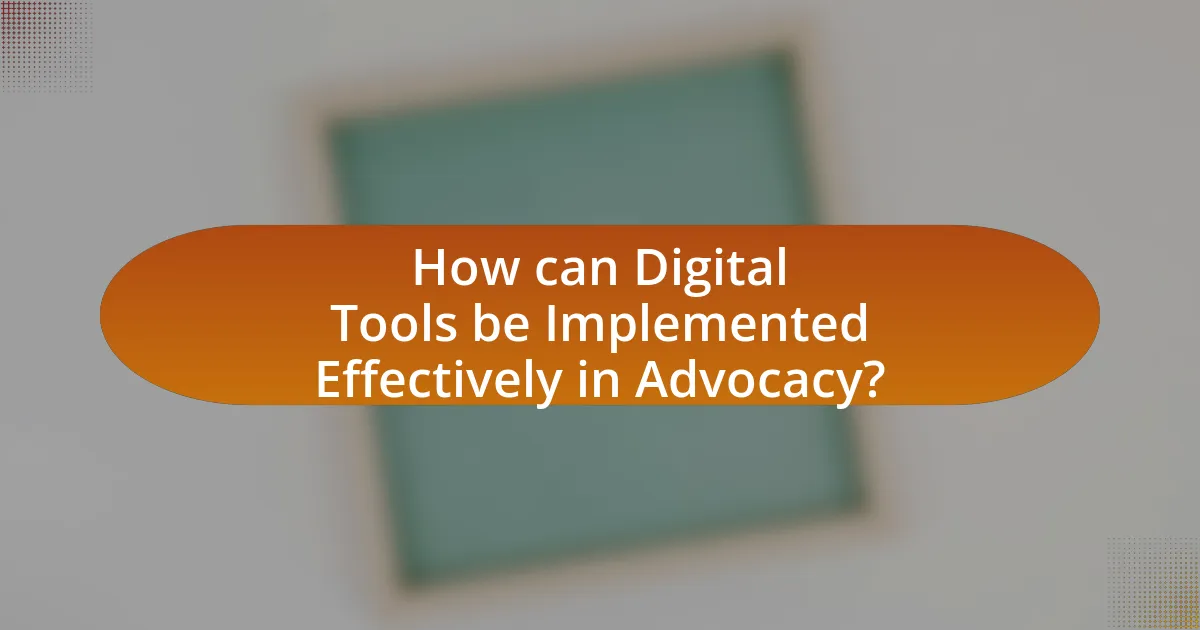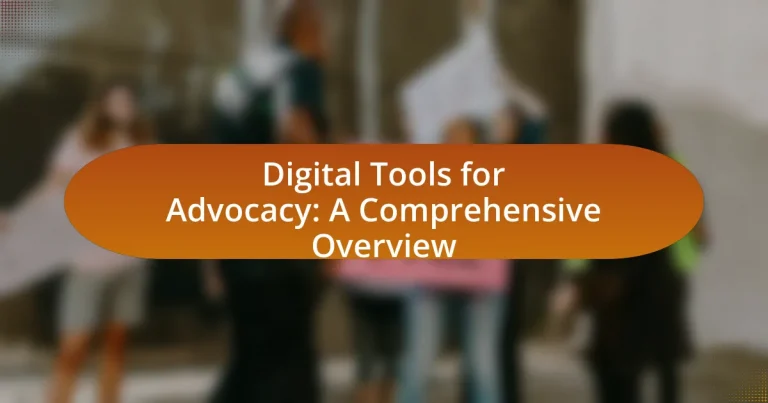Digital tools for advocacy encompass various online platforms and applications that enhance communication, mobilization, and engagement for social or political causes. This article provides a comprehensive overview of these tools, including social media networks, email campaigns, online petitions, and advocacy websites, highlighting their role in expanding outreach and influencing public opinion. Key sections cover the types of digital tools commonly used, their impact on advocacy efforts, effective strategies for implementation, and best practices for engaging diverse audiences. Additionally, the article addresses the importance of data privacy and the advantages of digital tools over traditional advocacy methods, emphasizing their significance in modern advocacy campaigns.

What are Digital Tools for Advocacy?
Digital tools for advocacy are online platforms and applications that facilitate communication, mobilization, and engagement for social or political causes. These tools include social media networks, email campaigns, online petitions, and advocacy websites, which enable organizations and individuals to reach wider audiences, share information, and influence public opinion. For instance, platforms like Change.org allow users to create and sign petitions, demonstrating the power of collective action in digital spaces. Additionally, social media channels such as Twitter and Facebook serve as vital tools for real-time communication and grassroots organizing, evidenced by movements like #MeToo and Black Lives Matter, which gained momentum through digital engagement.
How do Digital Tools enhance Advocacy efforts?
Digital tools enhance advocacy efforts by increasing outreach, facilitating communication, and enabling data-driven decision-making. These tools, such as social media platforms, email campaigns, and online petitions, allow advocates to connect with a broader audience quickly and efficiently. For instance, a study by the Pew Research Center found that 69% of adults in the U.S. use social media, providing a vast platform for advocacy messages to reach diverse demographics. Additionally, digital tools enable real-time feedback and engagement, allowing advocates to adjust their strategies based on audience responses and analytics. This adaptability is crucial for effective advocacy, as it helps organizations to refine their messaging and improve their impact.
What types of Digital Tools are commonly used in Advocacy?
Digital tools commonly used in advocacy include social media platforms, email marketing software, online petition tools, and data visualization applications. Social media platforms like Twitter and Facebook facilitate outreach and engagement with a broad audience, enabling advocates to share messages quickly. Email marketing software allows for targeted communication with supporters, helping to mobilize action and disseminate information effectively. Online petition tools, such as Change.org, provide a means for advocates to gather support and demonstrate public backing for their causes. Data visualization applications, like Tableau, help in presenting complex information in an accessible format, making it easier to communicate key messages and influence decision-makers. These tools collectively enhance the effectiveness of advocacy efforts by improving communication, mobilization, and data presentation.
How do these tools facilitate communication and engagement?
Digital tools for advocacy facilitate communication and engagement by providing platforms that enable real-time interaction and information sharing among stakeholders. These tools, such as social media, email campaigns, and dedicated advocacy platforms, allow organizations to disseminate messages quickly, mobilize supporters, and foster community discussions. For instance, a study by the Pew Research Center found that 69% of adults in the U.S. use social media, which enhances the reach and impact of advocacy efforts by connecting diverse audiences. Additionally, tools like online petitions and webinars create opportunities for direct engagement, allowing advocates to gather feedback and build relationships with their audience.
Why is it important to utilize Digital Tools in Advocacy?
Utilizing digital tools in advocacy is crucial because they enhance communication, broaden outreach, and increase engagement. Digital tools enable advocates to connect with a larger audience through social media platforms, email campaigns, and online petitions, which can significantly amplify their message. For instance, a study by the Pew Research Center found that 69% of adults in the U.S. use social media, making it an effective channel for advocacy efforts. Furthermore, digital tools facilitate real-time data collection and analysis, allowing advocates to adapt their strategies based on immediate feedback and trends. This adaptability is essential for effective advocacy in a rapidly changing digital landscape.
What advantages do Digital Tools provide over traditional methods?
Digital tools provide enhanced efficiency, accessibility, and data analysis capabilities compared to traditional methods. For instance, digital tools enable real-time communication and collaboration, allowing advocates to reach wider audiences quickly through social media and online platforms. Additionally, they facilitate the collection and analysis of large datasets, which can inform strategies and measure impact more effectively than manual methods. According to a report by the Pew Research Center, 72% of adults use social media, highlighting the potential reach of digital advocacy compared to traditional outreach methods.
How do Digital Tools impact the reach and effectiveness of Advocacy campaigns?
Digital tools significantly enhance the reach and effectiveness of advocacy campaigns by enabling broader audience engagement and facilitating real-time communication. These tools, such as social media platforms, email marketing, and online petitions, allow advocates to disseminate their messages quickly and widely, reaching diverse demographics that traditional methods may not access. For instance, a study by the Pew Research Center found that 69% of adults in the U.S. use social media, providing a vast platform for advocacy messages to gain visibility. Additionally, digital tools enable targeted outreach, allowing campaigns to tailor messages to specific groups based on data analytics, which increases the likelihood of engagement and action. This targeted approach has been shown to improve campaign effectiveness, as evidenced by the success of movements like #MeToo, which utilized social media to mobilize support and raise awareness on a global scale.

What are the Key Categories of Digital Tools for Advocacy?
The key categories of digital tools for advocacy include social media platforms, email marketing tools, online petition platforms, fundraising software, and data analytics tools. Social media platforms like Twitter and Facebook enable organizations to engage with audiences and spread awareness rapidly. Email marketing tools facilitate direct communication with supporters, allowing for targeted messaging. Online petition platforms, such as Change.org, empower individuals to mobilize support for specific causes. Fundraising software, like GoFundMe, assists in collecting donations efficiently. Lastly, data analytics tools help organizations measure the impact of their advocacy efforts and refine strategies based on insights gathered.
What are Social Media Platforms and how are they used in Advocacy?
Social media platforms are online services that enable users to create, share, and interact with content and each other. These platforms, such as Facebook, Twitter, Instagram, and LinkedIn, are utilized in advocacy to mobilize support, raise awareness, and facilitate communication around social issues. For instance, campaigns like the Ice Bucket Challenge effectively used social media to raise awareness and funds for ALS research, demonstrating the platforms’ capacity to reach large audiences quickly. Additionally, social media allows for real-time engagement and feedback, which can amplify advocacy messages and foster community building among supporters.
Which Social Media strategies are most effective for Advocacy?
Effective social media strategies for advocacy include targeted messaging, community engagement, and data-driven campaigns. Targeted messaging ensures that the content resonates with specific audiences, increasing the likelihood of engagement and support. Community engagement fosters a sense of belonging and encourages individuals to share their experiences, amplifying the advocacy message. Data-driven campaigns utilize analytics to measure impact and refine strategies, ensuring that resources are allocated effectively. For instance, a study by the Pew Research Center found that 69% of adults in the U.S. use social media, highlighting its potential reach for advocacy efforts.
How can Social Media analytics improve Advocacy efforts?
Social media analytics can significantly enhance advocacy efforts by providing data-driven insights into audience engagement and sentiment. By analyzing metrics such as likes, shares, comments, and demographic information, advocates can identify which messages resonate most with their target audience. For instance, a study by the Pew Research Center found that 69% of adults in the U.S. use social media, making it a vital platform for reaching diverse groups. Furthermore, social media analytics allows advocates to track the effectiveness of campaigns in real-time, enabling them to adjust strategies promptly based on audience feedback and engagement levels. This adaptability can lead to more impactful advocacy initiatives and increased support for causes.
What role do Email Campaigns play in Advocacy?
Email campaigns play a crucial role in advocacy by facilitating direct communication between organizations and their supporters. These campaigns enable advocates to mobilize supporters, disseminate information about issues, and encourage action, such as signing petitions or contacting legislators. According to a study by the Pew Research Center, 70% of adults in the U.S. prefer to receive updates from organizations via email, highlighting its effectiveness as a communication tool. Furthermore, email campaigns can significantly increase engagement; for instance, organizations that utilize targeted email strategies report a 20% higher response rate compared to non-targeted approaches. This demonstrates that email campaigns are essential for building relationships, raising awareness, and driving advocacy efforts.
How can Email Campaigns be optimized for better engagement?
Email campaigns can be optimized for better engagement by personalizing content, segmenting the audience, and utilizing A/B testing. Personalization increases open rates by 26% according to a study by Experian, as tailored messages resonate more with recipients. Segmenting the audience allows for targeted messaging, which can lead to a 760% increase in revenue, as reported by Campaign Monitor. A/B testing different subject lines and content formats helps identify what resonates best with the audience, leading to improved click-through rates. These strategies collectively enhance engagement and effectiveness of email campaigns.
What metrics should be tracked in Email Campaigns for Advocacy?
The key metrics to track in email campaigns for advocacy include open rates, click-through rates, conversion rates, bounce rates, and unsubscribe rates. Open rates indicate the percentage of recipients who opened the email, reflecting the effectiveness of the subject line and timing. Click-through rates measure the percentage of recipients who clicked on links within the email, showcasing engagement levels. Conversion rates track the percentage of recipients who completed a desired action, such as signing a petition or donating, which directly correlates to the campaign’s success. Bounce rates reveal the percentage of emails that could not be delivered, helping to assess the quality of the email list. Unsubscribe rates indicate how many recipients opted out, providing insight into content relevance and audience satisfaction. Tracking these metrics allows advocates to refine their strategies and improve future campaigns.
What are the benefits of using Online Petitions in Advocacy?
Online petitions in advocacy provide a platform for mobilizing support and raising awareness on specific issues. They enable advocates to reach a wider audience quickly, facilitating the collection of signatures and demonstrating public support to decision-makers. For instance, a study by the Pew Research Center found that 70% of online petition signers reported feeling more engaged in civic activities after participating. Additionally, online petitions can be shared across social media, amplifying their reach and impact, which is crucial in today’s digital landscape where information spreads rapidly. This combination of accessibility, engagement, and visibility makes online petitions a powerful tool in advocacy efforts.
How do Online Petitions mobilize supporters effectively?
Online petitions mobilize supporters effectively by leveraging digital platforms to facilitate easy access and engagement. These petitions often utilize social media integration, allowing users to share their support quickly, which amplifies reach and visibility. Research indicates that petitions with social sharing options can increase signatures by up to 50%, demonstrating the power of network effects in mobilization. Additionally, online petitions often include compelling narratives and visuals that resonate emotionally with potential supporters, enhancing their likelihood of participation. The combination of accessibility, social sharing, and emotional appeal creates a potent mechanism for mobilizing individuals around a cause.
What platforms are best for creating Online Petitions?
The best platforms for creating online petitions include Change.org, Care2 Petitions, and Petition.org. Change.org is widely recognized for its user-friendly interface and extensive reach, allowing users to create petitions that can gain significant traction. Care2 Petitions offers a strong community focus, enabling users to connect with like-minded individuals and organizations. Petition.org provides a straightforward platform for petition creation and sharing, making it accessible for users of all experience levels. These platforms have collectively facilitated millions of petitions, demonstrating their effectiveness in mobilizing public support for various causes.

How can Digital Tools be Implemented Effectively in Advocacy?
Digital tools can be implemented effectively in advocacy by integrating data analytics, social media engagement, and targeted communication strategies. Data analytics allows organizations to identify key demographics and tailor their messages accordingly, enhancing outreach effectiveness. Social media platforms facilitate real-time interaction and mobilization, enabling advocates to reach wider audiences quickly; for instance, campaigns that utilize hashtags can trend and gain visibility rapidly. Targeted communication strategies, such as personalized emails and segmented messaging, ensure that the right information reaches the appropriate stakeholders, increasing the likelihood of engagement and action. According to a 2020 report by the Pew Research Center, 69% of adults in the U.S. use social media, highlighting its potential as a powerful tool for advocacy.
What strategies should be employed for successful Digital Advocacy?
Successful digital advocacy requires a multi-faceted approach that includes leveraging social media, creating compelling content, and engaging with target audiences. Social media platforms, such as Twitter and Facebook, allow advocates to reach a broad audience quickly; for instance, campaigns that utilize hashtags can increase visibility and engagement significantly. Compelling content, including videos, infographics, and articles, can effectively convey messages and mobilize support, as evidenced by the success of the Ice Bucket Challenge, which raised over $115 million for ALS research through engaging storytelling. Engaging with target audiences through interactive elements, such as polls and live Q&A sessions, fosters community involvement and strengthens advocacy efforts. These strategies collectively enhance the effectiveness of digital advocacy campaigns.
How can organizations measure the success of their Digital Advocacy efforts?
Organizations can measure the success of their Digital Advocacy efforts through key performance indicators (KPIs) such as engagement rates, conversion rates, and reach metrics. Engagement rates can be assessed by analyzing likes, shares, comments, and overall interaction with advocacy content across social media platforms. Conversion rates indicate the percentage of users who take a desired action, such as signing a petition or donating, which can be tracked using analytics tools. Reach metrics provide insights into the number of individuals exposed to advocacy messages, often measured through impressions and unique visitors on websites or social media. These metrics collectively offer a comprehensive view of the effectiveness of digital advocacy campaigns, allowing organizations to adjust strategies based on data-driven insights.
What are common pitfalls to avoid when using Digital Tools for Advocacy?
Common pitfalls to avoid when using digital tools for advocacy include neglecting audience engagement, failing to verify information, and not measuring impact. Neglecting audience engagement can lead to ineffective communication, as advocacy efforts may not resonate with the target demographic. Failing to verify information can result in spreading misinformation, which undermines credibility and trust. Not measuring impact prevents advocates from understanding the effectiveness of their strategies, making it difficult to refine approaches for better outcomes. These pitfalls can significantly hinder the success of advocacy campaigns and diminish their overall effectiveness.
How can organizations ensure inclusivity in their Digital Advocacy efforts?
Organizations can ensure inclusivity in their digital advocacy efforts by actively engaging diverse communities and incorporating their feedback into campaign strategies. This approach involves utilizing accessible digital platforms that cater to various demographics, including those with disabilities, and ensuring content is available in multiple languages. Research indicates that inclusive digital advocacy can increase engagement by up to 50%, as seen in campaigns that prioritize representation and accessibility. By implementing these practices, organizations can create a more equitable digital space that amplifies underrepresented voices.
What practices promote accessibility in Digital Tools for Advocacy?
Practices that promote accessibility in digital tools for advocacy include implementing universal design principles, ensuring compatibility with assistive technologies, and providing alternative text for images. Universal design principles focus on creating tools that are usable by people with diverse abilities, which enhances overall user experience. Compatibility with assistive technologies, such as screen readers and voice recognition software, ensures that individuals with disabilities can effectively engage with the tools. Providing alternative text for images allows visually impaired users to understand visual content, thereby making information accessible. These practices are supported by guidelines such as the Web Content Accessibility Guidelines (WCAG), which outline standards for making web content more accessible to people with disabilities.
How can diverse audiences be effectively engaged through Digital Tools?
Diverse audiences can be effectively engaged through digital tools by utilizing targeted content, interactive platforms, and data analytics. Targeted content ensures that messaging resonates with specific demographics, enhancing relevance and engagement. For instance, social media platforms like Facebook and Instagram allow for demographic targeting, enabling organizations to tailor their messages based on age, location, and interests. Interactive platforms, such as webinars and live Q&A sessions, foster real-time engagement, allowing audiences to participate actively rather than passively consume information. Data analytics further supports this engagement by providing insights into audience behavior and preferences, enabling continuous improvement of strategies. According to a report by the Pew Research Center, 72% of the public uses social media, highlighting its potential as a tool for reaching diverse groups effectively.
What are some best practices for using Digital Tools in Advocacy?
Best practices for using digital tools in advocacy include leveraging social media for outreach, utilizing data analytics for targeted messaging, and employing storytelling techniques to engage audiences. Social media platforms like Twitter and Facebook enable advocates to reach a broader audience quickly, as evidenced by the rapid mobilization of movements such as #MeToo, which gained global attention through strategic online engagement. Data analytics tools allow organizations to analyze audience demographics and tailor their messages effectively, enhancing engagement rates; for instance, studies show that targeted campaigns can increase conversion rates by up to 50%. Additionally, storytelling is a powerful method to connect emotionally with supporters, as narratives can significantly influence public opinion and drive action, supported by research indicating that stories are 22 times more memorable than facts alone.
How can storytelling enhance the impact of Digital Advocacy?
Storytelling enhances the impact of digital advocacy by creating emotional connections that engage audiences more effectively than data alone. When narratives are used, they can simplify complex issues, making them relatable and memorable, which increases the likelihood of audience action. Research indicates that stories can improve information retention by up to 65%, as they activate different parts of the brain compared to straightforward facts. This emotional engagement can lead to higher levels of sharing and participation in advocacy campaigns, ultimately driving greater awareness and support for causes.
What role does data privacy play in Digital Advocacy strategies?
Data privacy is crucial in digital advocacy strategies as it builds trust with constituents and protects sensitive information. When organizations prioritize data privacy, they enhance their credibility and foster stronger relationships with their audience, which is essential for effective advocacy. According to a 2021 survey by the Pew Research Center, 79% of Americans expressed concern about how their data is used by companies, indicating that a commitment to data privacy can significantly influence public perception and engagement. Furthermore, compliance with data protection regulations, such as the General Data Protection Regulation (GDPR), not only mitigates legal risks but also demonstrates a commitment to ethical practices in advocacy efforts.


